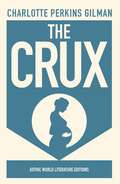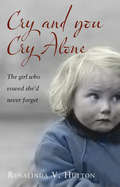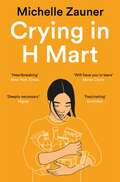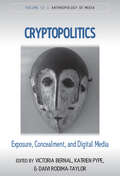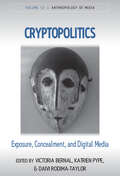- Table View
- List View
Crusoe's Footprints: Cultural Studies in Britain and America
by Patrick Brantlinger"Cultural Studies" has emerged in British and American higher education as a movement that challenges the traditional humanities and social science disciplines. Influenced by the New Left, feminism, and poststructualist literary theory, cultural studies seeks to analyze everday life and the social construction of "subjectivities." Crusoe's Footprints encompasses the movement of many colleges and universities in the 1960s towards such interdisciplinary and "radical" programs as American Studies, Women's Studies, and Afro-American Studies. Brantlinger also examines the role of feminist criticism which has been particularly crucial in both Britain and the U.S.
Crusoe's Footprints: Cultural Studies in Britain and America
by Patrick Brantlinger"Cultural Studies" has emerged in British and American higher education as a movement that challenges the traditional humanities and social science disciplines. Influenced by the New Left, feminism, and poststructualist literary theory, cultural studies seeks to analyze everday life and the social construction of "subjectivities." Crusoe's Footprints encompasses the movement of many colleges and universities in the 1960s towards such interdisciplinary and "radical" programs as American Studies, Women's Studies, and Afro-American Studies. Brantlinger also examines the role of feminist criticism which has been particularly crucial in both Britain and the U.S.
The Crux
by Charlotte Perkins Gilman“In place of happy love, lonely pain. In place of motherhood, disease. Misery and shame, child. Medicine and surgery, and never any possibility of any child for me."First published in her magazine The Forerunner, Charlotte Perkins Gilman’s The Crux is an emotive tale on the nuances of female independence, social expectation and love in early 20th century America.Following an all-female group who move west to open a boarding house for men, The Crux focuses on the experience of Vivian ― and her desire for the undesirable. Deeply in love with Morton, a charismatic young man infected with both syphilis and gonorrhoea, Vivian’s expected journey through her ‘marriage’ years is abruptly turned upside down.Torn by her personal intuition, the advice provided by her female companions and the knowledge that Morton will never give her healthy children, Vivian is faced with a permanent choice ― to forfeit love for the benefit of future generations.Balancing female and male perspectives on illness, personal preservation and nationalism, The Crux tracks Vivian’s path through heart break, emotional development and female camaraderie.As an allegory for Gilman’s own branch of utopian feminism, The Crux is a story of sacrifice and partnership deliberation within the framework of 20th century disease hysteria, eugenic ideology and developing modernism.Often omitted from her writing canon, The Crux is an integral aspect to understanding not only Gilman’s own writing ― but the history of feminism as a whole.“The Crux is essentially a seminar in biological, feminine and social correctness. As stated in the original Forerunner publication, the novel was intended for a specific set of people - young and impressionable women primarily, followed by men and anyone else willing to listen. The Crux, in its barebones, is a nationalist parable for all of America to heed.”from Ambrose Kelly's new introduction to The Crux* * *Charlotte Perkins Gilman (1860 – 1935) was an American humanist, novelist, writer of short stories, poetry and nonfiction, and a lecturer for social reform. She was a utopian feminist and served as a role model for future generations of feminists because of her unorthodox concepts and lifestyle.
Cry and You Cry Alone: The Girl Who Vowed She'd Never Forget
by Rosalinda V. HuttonAfter an idyllic early childhood in Surrey, Linda's life descended into poverty and chaos when her parents' marriage crumbled and her unstable mother's sanity declined.She experienced a brief period of comfort in a caring foster home before being plunged into the dark, terrifying world of a 1960s institution. St Anne's Convent, Orpington, was a Catholic children's home run by the infamous Sisters of Mercy and a former monk who inflicted bizarre and barbaric beliefs and practices on the children in his care.Cry and You Cry Alone is the achingly honest story of a survivor of shocking child abuse that took place in the heart of an English suburb.
Crying for Our Elders: African Orphanhood in the Age of HIV and AIDS
by Kristen E. CheneyThe HIV/AIDS epidemic in Africa has defined the childhoods of an entire generation. Over the past twenty years, international NGOs and charities have devoted immense attention to the millions of African children orphaned by the disease. But in Crying for Our Elders, anthropologist Kristen E. Cheney argues that these humanitarian groups have misread the ‘orphan crisis’. She explains how the global humanitarian focus on orphanhood often elides the social and political circumstances that actually present the greatest adversity to vulnerable children—in effect deepening the crisis and thereby affecting children’s lives as irrevocably as HIV/AIDS itself. Through ethnographic fieldwork and collaborative research with children in Uganda, Cheney traces how the “best interest” principle that governs children’s’ rights can stigmatize orphans and leave children in the post-antiretroviral era even more vulnerable to exploitation. She details the dramatic effects this has on traditional family support and child protection and stresses child empowerment over pity. Crying for Our Elders advances current discussions on humanitarianism, children’s studies, orphanhood, and kinship. By exploring the unique experience of AIDS orphanhood through the eyes of children, caregivers, and policymakers, Cheney shows that despite the extreme challenges of growing up in the era of HIV/AIDS, the post-ARV generation still holds out hope for the future.
Crying for Our Elders: African Orphanhood in the Age of HIV and AIDS
by Kristen E. CheneyThe HIV/AIDS epidemic in Africa has defined the childhoods of an entire generation. Over the past twenty years, international NGOs and charities have devoted immense attention to the millions of African children orphaned by the disease. But in Crying for Our Elders, anthropologist Kristen E. Cheney argues that these humanitarian groups have misread the ‘orphan crisis’. She explains how the global humanitarian focus on orphanhood often elides the social and political circumstances that actually present the greatest adversity to vulnerable children—in effect deepening the crisis and thereby affecting children’s lives as irrevocably as HIV/AIDS itself. Through ethnographic fieldwork and collaborative research with children in Uganda, Cheney traces how the “best interest” principle that governs children’s’ rights can stigmatize orphans and leave children in the post-antiretroviral era even more vulnerable to exploitation. She details the dramatic effects this has on traditional family support and child protection and stresses child empowerment over pity. Crying for Our Elders advances current discussions on humanitarianism, children’s studies, orphanhood, and kinship. By exploring the unique experience of AIDS orphanhood through the eyes of children, caregivers, and policymakers, Cheney shows that despite the extreme challenges of growing up in the era of HIV/AIDS, the post-ARV generation still holds out hope for the future.
Crying for Our Elders: African Orphanhood in the Age of HIV and AIDS
by Kristen E. CheneyThe HIV/AIDS epidemic in Africa has defined the childhoods of an entire generation. Over the past twenty years, international NGOs and charities have devoted immense attention to the millions of African children orphaned by the disease. But in Crying for Our Elders, anthropologist Kristen E. Cheney argues that these humanitarian groups have misread the ‘orphan crisis’. She explains how the global humanitarian focus on orphanhood often elides the social and political circumstances that actually present the greatest adversity to vulnerable children—in effect deepening the crisis and thereby affecting children’s lives as irrevocably as HIV/AIDS itself. Through ethnographic fieldwork and collaborative research with children in Uganda, Cheney traces how the “best interest” principle that governs children’s’ rights can stigmatize orphans and leave children in the post-antiretroviral era even more vulnerable to exploitation. She details the dramatic effects this has on traditional family support and child protection and stresses child empowerment over pity. Crying for Our Elders advances current discussions on humanitarianism, children’s studies, orphanhood, and kinship. By exploring the unique experience of AIDS orphanhood through the eyes of children, caregivers, and policymakers, Cheney shows that despite the extreme challenges of growing up in the era of HIV/AIDS, the post-ARV generation still holds out hope for the future.
Crying for Our Elders: African Orphanhood in the Age of HIV and AIDS
by Kristen E. CheneyThe HIV/AIDS epidemic in Africa has defined the childhoods of an entire generation. Over the past twenty years, international NGOs and charities have devoted immense attention to the millions of African children orphaned by the disease. But in Crying for Our Elders, anthropologist Kristen E. Cheney argues that these humanitarian groups have misread the ‘orphan crisis’. She explains how the global humanitarian focus on orphanhood often elides the social and political circumstances that actually present the greatest adversity to vulnerable children—in effect deepening the crisis and thereby affecting children’s lives as irrevocably as HIV/AIDS itself. Through ethnographic fieldwork and collaborative research with children in Uganda, Cheney traces how the “best interest” principle that governs children’s’ rights can stigmatize orphans and leave children in the post-antiretroviral era even more vulnerable to exploitation. She details the dramatic effects this has on traditional family support and child protection and stresses child empowerment over pity. Crying for Our Elders advances current discussions on humanitarianism, children’s studies, orphanhood, and kinship. By exploring the unique experience of AIDS orphanhood through the eyes of children, caregivers, and policymakers, Cheney shows that despite the extreme challenges of growing up in the era of HIV/AIDS, the post-ARV generation still holds out hope for the future.
Crying for Our Elders: African Orphanhood in the Age of HIV and AIDS
by Kristen E. CheneyThe HIV/AIDS epidemic in Africa has defined the childhoods of an entire generation. Over the past twenty years, international NGOs and charities have devoted immense attention to the millions of African children orphaned by the disease. But in Crying for Our Elders, anthropologist Kristen E. Cheney argues that these humanitarian groups have misread the ‘orphan crisis’. She explains how the global humanitarian focus on orphanhood often elides the social and political circumstances that actually present the greatest adversity to vulnerable children—in effect deepening the crisis and thereby affecting children’s lives as irrevocably as HIV/AIDS itself. Through ethnographic fieldwork and collaborative research with children in Uganda, Cheney traces how the “best interest” principle that governs children’s’ rights can stigmatize orphans and leave children in the post-antiretroviral era even more vulnerable to exploitation. She details the dramatic effects this has on traditional family support and child protection and stresses child empowerment over pity. Crying for Our Elders advances current discussions on humanitarianism, children’s studies, orphanhood, and kinship. By exploring the unique experience of AIDS orphanhood through the eyes of children, caregivers, and policymakers, Cheney shows that despite the extreme challenges of growing up in the era of HIV/AIDS, the post-ARV generation still holds out hope for the future.
Crying for Our Elders: African Orphanhood in the Age of HIV and AIDS
by Kristen E. CheneyThe HIV/AIDS epidemic in Africa has defined the childhoods of an entire generation. Over the past twenty years, international NGOs and charities have devoted immense attention to the millions of African children orphaned by the disease. But in Crying for Our Elders, anthropologist Kristen E. Cheney argues that these humanitarian groups have misread the ‘orphan crisis’. She explains how the global humanitarian focus on orphanhood often elides the social and political circumstances that actually present the greatest adversity to vulnerable children—in effect deepening the crisis and thereby affecting children’s lives as irrevocably as HIV/AIDS itself. Through ethnographic fieldwork and collaborative research with children in Uganda, Cheney traces how the “best interest” principle that governs children’s’ rights can stigmatize orphans and leave children in the post-antiretroviral era even more vulnerable to exploitation. She details the dramatic effects this has on traditional family support and child protection and stresses child empowerment over pity. Crying for Our Elders advances current discussions on humanitarianism, children’s studies, orphanhood, and kinship. By exploring the unique experience of AIDS orphanhood through the eyes of children, caregivers, and policymakers, Cheney shows that despite the extreme challenges of growing up in the era of HIV/AIDS, the post-ARV generation still holds out hope for the future.
Crying in H Mart: A Memoir
by Michelle ZaunerFrom the indie rockstar Japanese Breakfast, and author of the viral 2018 New Yorker piece that shares the title of this book, an unflinching, powerful memoir about growing up mixed-race, of Korean food, losing her Korean mother, and forging her own identity.In this exquisite story of family, food, grief, and endurance, Michelle Zauner proves herself far more than a dazzling singer, songwriter, and guitarist. With humour and heart, she tells of growing up the only Asian-American kid at her school in Eugene, Oregon; of struggling with her mother’s particular, high expectations of her; of a painful adolescence; of treasured months spent in her grandmother’s tiny apartment in Seoul, where she and her mother would bond, late at night, over heaping plates of food. As she grew up, moving to the east coast for college, finding work in the restaurant industry, performing gigs with her fledgling band – and meeting the man who would become her husband – her Koreanness began to feel ever more distant, even as she found the life she wanted to live. It was her mother’s diagnosis of terminal pancreatic cancer, when Michelle was twenty-five, that forced a reckoning with her identity and brought her to reclaim the gifts of taste, language, and history her mother had given her. Vivacious and plainspoken, lyrical and honest, Michelle Zauner’s voice is as radiantly alive on the page as it is onstage. Rich with intimate anecdotes that will resonate widely, Crying in H Mart is a book to cherish, share, and reread.
Crying Shame: Metaculture, Modernity, and the Exaggerated Death of Lament
by James M. WilceBuilding on ethnographic fieldwork and extensive historical evidence, Crying Shame analyzes lament across thousands of years and nearly every continent. Explores the enduring power of lament: expressing grief through crying songs, often in a collective ritual context Draws on the author’s extensive ethnographic fieldwork, and unique long-term engagement and participation in the phenomenon Offers a startling new perspective on the nature of modernity and postmodernity An important addition to growing literature on cultural globalization
Crying the News: A History of America's Newsboys
by Vincent DiGirolamoFrom Benjamin Franklin to Ragged Dick to Jack Kelly, hero of the Disney musical Newsies, newsboys have long intrigued Americans as symbols of struggle and achievement. But what do we really know about the children who hawked and delivered newspapers in American cities and towns? Who were they? What was their life like? And how important was their work to the development of a free press, the survival of poor families, and the shaping of their own attitudes, values and beliefs? Crying the News: A History of America's Newsboys offers an epic retelling of the American experience from the perspective of its most unshushable creation. It is the first book to place newsboys at the center of American history, analyzing their inseparable role as economic actors and cultural symbols in the creation of print capitalism, popular democracy, and national character. DiGirolamo's sweeping narrative traces the shifting fortunes of these "little merchants" over a century of war and peace, prosperity and depression, exploitation and reform, chronicling their exploits in every region of the country, as well as on the railroads that linked them. While the book focuses mainly on boys in the trade, it also examines the experience of girls and grown-ups, the elderly and disabled, blacks and whites, immigrants and natives. Based on a wealth of primary sources, Crying the News uncovers the existence of scores of newsboy strikes and protests. The book reveals the central role of newsboys in the development of corporate welfare schemes, scientific management practices, and employee liability laws. It argues that the newspaper industry exerted a formative yet overlooked influence on working-class youth that is essential to our understanding of American childhood, labor, journalism, and capitalism.
Crying the News: A History of America's Newsboys
by Vincent DiGirolamoFrom Benjamin Franklin to Ragged Dick to Jack Kelly, hero of the Disney musical Newsies, newsboys have long intrigued Americans as symbols of struggle and achievement. But what do we really know about the children who hawked and delivered newspapers in American cities and towns? Who were they? What was their life like? And how important was their work to the development of a free press, the survival of poor families, and the shaping of their own attitudes, values and beliefs? Crying the News: A History of America's Newsboys offers an epic retelling of the American experience from the perspective of its most unshushable creation. It is the first book to place newsboys at the center of American history, analyzing their inseparable role as economic actors and cultural symbols in the creation of print capitalism, popular democracy, and national character. DiGirolamo's sweeping narrative traces the shifting fortunes of these "little merchants" over a century of war and peace, prosperity and depression, exploitation and reform, chronicling their exploits in every region of the country, as well as on the railroads that linked them. While the book focuses mainly on boys in the trade, it also examines the experience of girls and grown-ups, the elderly and disabled, blacks and whites, immigrants and natives. Based on a wealth of primary sources, Crying the News uncovers the existence of scores of newsboy strikes and protests. The book reveals the central role of newsboys in the development of corporate welfare schemes, scientific management practices, and employee liability laws. It argues that the newspaper industry exerted a formative yet overlooked influence on working-class youth that is essential to our understanding of American childhood, labor, journalism, and capitalism.
Crypto Confidential: Winning and Losing Millions in the New Frontier of Finance
by Nathaniel EliasonTHE WILD INSIDE STORY OF CRYPTO'S GET-RICH-QUICK UNDERBELLYNat Eliason had six months to make as much money as possible before his first child was born.So, he turned to where countless others did in 2021: crypto.Within a year, he'd made millions writing code holding hundreds of millions of dollars of other people's money. He'd been hacked. He'd sold a picture of a monkey for two hundred grand. He'd become an influencer, speaking at conferences, and writing a weekly newsletter to tens of thousands of fans. Best of all, Nat had amassed a small fortune. But how much of this money was even real? And how many times can someone double down before they eventually lose everything?Crypto Confidential is Nat's unfiltered, insider's account of the hyperactive, hyper-speculative, hyper-addictive, nearly unregulated, completely insane world being built on the blockchain. A story of getting rich, going broke, scamming and getting scammed - and how we can all be more educated participants during the inevitable next bull run.'A great look from the trenches to understand the good and bad of cryptocurrency from the inside out' Reid Hoffman, co-founder of LinkedIn and Inflection AI
Crypto Crowds: Singularities and Multiplicities on the Blockchain (Critical Interventions: A Forum for Social Analysis #21)
by Matan ShapiroOwnership of cryptocurrencies features contrasting forms of mobilization. On one hand, it denotes association with a global crowd of unrelated individual investors, which expands as it attracts more members. On the other hand, it includes participation in grassroots communities, which are generally more insular. Crypto Crowds demonstrates how this tension generates political, economic and moral realities in different cultural and geographical contexts. Pioneering in its approach to cryptocurrency trading, this volume will inspire scholars interested in the sociality of decentralized business models, boom-and-bust cycles on the blockchain, libertarian utopias and other postmodern crowding phenomena.
Crypto Crowds: Singularities and Multiplicities on the Blockchain (Critical Interventions: A Forum for Social Analysis #21)
by Matan ShapiroOwnership of cryptocurrencies features contrasting forms of mobilization. On one hand, it denotes association with a global crowd of unrelated individual investors, which expands as it attracts more members. On the other hand, it includes participation in grassroots communities, which are generally more insular. Crypto Crowds demonstrates how this tension generates political, economic and moral realities in different cultural and geographical contexts. Pioneering in its approach to cryptocurrency trading, this volume will inspire scholars interested in the sociality of decentralized business models, boom-and-bust cycles on the blockchain, libertarian utopias and other postmodern crowding phenomena.
The Crypto-Jewish Mashhadis: The Shaping of Religious and Communal Identity in their Journey from Iran to New York
by Hilda NissimiThis book tells the little-known story of a fascinating crypto-Jewish community through two centuries and three continents. Beginning as a precarious settlement of a few families in mid-18th-century Mashhad, an Islamic holy city in northern Iran, the community grew into a closely-knit group in response to their forced conversion to Islam in 1839. Muslim hostility and a culture of memory sustained by intra-communal marriages reinforced their separate religious identity, vesting it in strong family and communal loyalty. Mashhadi women became the main agents of the cultural transmission of communal identity and achieved social roles and high status uncharacteristic for contemporary Jewish and Muslim communities. The Mashhadis maintained a double identity, upholding Islam in public while tenaciously holding onto their Jewish identity in secret. The exodus from Mashhad after 1946 relocated the communal center to Tehran, later to Israel, and, after the Khomeini revolution, to New York. The relationship between the formation and retention of communal identity and memory practices - with interconnected issues of religion and gender - draws upon existing research on other crypto-faith communities, such as the Judeoconversos, the Moriscos, and the French Protestants, who, through the special blend of memory-faith and ethnicity, emerged strengthened from their underground period. For the immigration period, the author challenges the old paradigm that "modernity and religion are mutually exclusive." The book also explores the sometimes uncomfortable yet intimate relationships that exist between seemingly incompatible ways of seeing the past, both secular and religious.
The Crypto-Jewish Mashhadis: The Shaping of Religious and Communal Identity in their Journey from Iran to New York
by Hilda NissimiThis book tells the little-known story of a fascinating crypto-Jewish community through two centuries and three continents. Beginning as a precarious settlement of a few families in mid-18th-century Mashhad, an Islamic holy city in northern Iran, the community grew into a closely-knit group in response to their forced conversion to Islam in 1839. Muslim hostility and a culture of memory sustained by intra-communal marriages reinforced their separate religious identity, vesting it in strong family and communal loyalty. Mashhadi women became the main agents of the cultural transmission of communal identity and achieved social roles and high status uncharacteristic for contemporary Jewish and Muslim communities. The Mashhadis maintained a double identity, upholding Islam in public while tenaciously holding onto their Jewish identity in secret. The exodus from Mashhad after 1946 relocated the communal center to Tehran, later to Israel, and, after the Khomeini revolution, to New York. The relationship between the formation and retention of communal identity and memory practices - with interconnected issues of religion and gender - draws upon existing research on other crypto-faith communities, such as the Judeoconversos, the Moriscos, and the French Protestants, who, through the special blend of memory-faith and ethnicity, emerged strengthened from their underground period. For the immigration period, the author challenges the old paradigm that "modernity and religion are mutually exclusive." The book also explores the sometimes uncomfortable yet intimate relationships that exist between seemingly incompatible ways of seeing the past, both secular and religious.
Cryptocurrencies and Blockchains
by Quinn DuPontFrom their shadowy origins in Bitcoin to their use by multinational corporations, cryptocurrencies and blockchains are remaking the rules of digital media and society. Meanwhile, regulators, governments, and the public are trying to make sense of it all. In this accessible book, Quinn DuPont guides readers through the changing face of money to show how blockchain technology underpins new forms of value exchange and social coordination. He introduces cryptocurrency and blockchain technology to readers in terms of their developers and users, investment opportunities and risks, changes to politics and law, social and industrial applications - and what this all means for the new economy. The author argues throughout that, rather than being a technical innovation, cryptocurrencies and blockchains are social technologies enabling developers and users to engage in unprecedented experiments with social and political levers. Cryptocurrencies and Blockchains dispenses with hype and offers sober reflection on this crucial and timely topic. It is essential reading for students and scholars of culture, politics, media, and the economy, as well as anyone who wants to understand, take part in, or change the future of work and society.
The Cryptocurrency and Digital Asset Fraud Casebook, Volume II: DeFi, NFTs, DAOs, Meme Coins, and Other Digital Asset Hacks
by Jason ScharfmanCryptocurrencies and digital assets have continued to gain widespread acceptance from both retail and institutional investors. As part of this continued growth, there has been an unfortunate series of ongoing and increasingly sophisticated frauds, Ponzi schemes, and hacks that have cost investors billions of dollars. Since the publication of the original Cryptocurrency and Digital Asset Fraud Casebook, conservative estimates indicate that there have been thousands of new digital asset fraud cases that have contributed to billions in broadening losses in space. Beyond the digital asset space, cryptocurrency-related scams also continue to present increasingly meaningful threats to traditional finance institutions, the global economy, and national security, as well. These new challenges, combined with the ongoing evolving regulatory environment for digital assets, create an environment where there is a continued need for the up-to-date information and analysis of real-world case studies. It includes an up-to-date analysis of recent case studies in cryptocurrency and digital asset fraud alongside an analysis of recent decentralized finance (DeFi) hacks, smart contract attacks, and rug pulls. This book reviews the impact of digital asset bankruptcies, the FTX fraud, and the industry-wide post-FTX fallout on the growth of cryptocurrency fraud. It also examines the explosive growth of cryptocurrency romance scams, pig butchering, and related organized crime money laundering efforts and includes a related exclusive case study. Offering an in-depth examination of digital asset frauds in the gaming, metaverse, and NFT spaces, it also covers Decentralized Autonomous Organization (DAO) fraud, smart contract attacks, dApp scams, crypto asset manager investment fraud, mining fraud, honeypots, meme coins, and artificial intelligence-based digital asset fraud. Leveraging the author’s experience analyzing and implementing compliance and operations best practices with a variety of cryptocurrency and digital asset projects and consulting with international regulators on blockchain and digital asset policy, this book will be of interest to those working throughout the cryptocurrency and digital asset space including Web 3.0 builders and service providers including lawyers, auditors, blockchain infrastructure, regulators, governments, retail investors, and institutional investors.
Cryptomarkets: A Research Companion (Emerald Studies In Digital Crime, Technology and Social Harms)
by James Martin Jack Cunliffe Rasmus MunksgaardSince the launch of the infamous Silk Road, the use of cryptomarkets - illicit markets for drugs on the dark web - has expanded rapidly around the world. Cryptomarkets: A Research Companion is an accessible, detailed guidebook which offers all the tools necessary to begin researching cryptomarket phenomena and the dark web trade in illicit drugs. Offering an in-depth historical account of the development of cryptomarkets up until the present day, the book goes on to examine key trends and findings regarding the contemporary operations of cryptomarkets. The principal methodologies used to conduct cryptomarket research, as well as questions regarding research ethics, are further explored. Finally, the authors outline underdeveloped areas of the field and pose key questions for future cryptomarket research. Whether an academic researcher, post-graduate student, law enforcement officer, or public health professional, this book is essential reading for those researching and working in the realm of cryptomarkets.
Cryptomarkets: A Research Companion (Emerald Studies In Digital Crime, Technology and Social Harms)
by James Martin Jack Cunliffe Rasmus MunksgaardSince the launch of the infamous Silk Road, the use of cryptomarkets - illicit markets for drugs on the dark web - has expanded rapidly around the world. Cryptomarkets: A Research Companion is an accessible, detailed guidebook which offers all the tools necessary to begin researching cryptomarket phenomena and the dark web trade in illicit drugs. Offering an in-depth historical account of the development of cryptomarkets up until the present day, the book goes on to examine key trends and findings regarding the contemporary operations of cryptomarkets. The principal methodologies used to conduct cryptomarket research, as well as questions regarding research ethics, are further explored. Finally, the authors outline underdeveloped areas of the field and pose key questions for future cryptomarket research. Whether an academic researcher, post-graduate student, law enforcement officer, or public health professional, this book is essential reading for those researching and working in the realm of cryptomarkets.
Cryptopolitics: Exposure, Concealment, and Digital Media (Anthropology of Media #12)
by Victoria Bernal Katrien Pype Daivi Rodima-TaylorHidden information, double meanings, double-crossing, and the constant processes of encoding and decoding messages have always been important techniques in negotiating social and political power dynamics. Yet these tools, “cryptopolitics,” are transformed when used within digital media. Focusing on African societies, Cryptopolitics brings together empirically grounded studies of digital media toconsider public culture, sociality, and power in all its forms, illustrating the analytical potential of cryptopolitics to elucidate intimate relationships, political protest, and economic strategies in the digital age.
Cryptopolitics: Exposure, Concealment, and Digital Media (Anthropology of Media #12)
by Victoria Bernal, Katrien Pype, and Daivi Rodima-TaylorHidden information, double meanings, double-crossing, and the constant processes of encoding and decoding messages have always been important techniques in negotiating social and political power dynamics. Yet these tools, “cryptopolitics,” are transformed when used within digital media. Focusing on African societies, Cryptopolitics brings together empirically grounded studies of digital media toconsider public culture, sociality, and power in all its forms, illustrating the analytical potential of cryptopolitics to elucidate intimate relationships, political protest, and economic strategies in the digital age.

